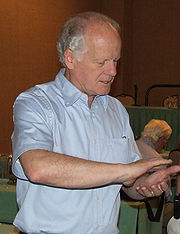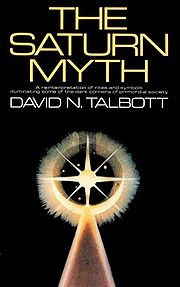
David Talbott
Encyclopedia

United States
The United States of America is a federal constitutional republic comprising fifty states and a federal district...
author and inveterate promoter of neo-Velikovskian ideas. Inspired by Immanuel Velikovsky
Immanuel Velikovsky
Immanuel Velikovsky was a Russian-born American independent scholar of Jewish origins, best known as the author of a number of controversial books reinterpreting the events of ancient history, in particular the US bestseller Worlds in Collision, published in 1950...
, he proposes a “Polar Configuration” involving the five planets, Jupiter
Jupiter
Jupiter is the fifth planet from the Sun and the largest planet within the Solar System. It is a gas giant with mass one-thousandth that of the Sun but is two and a half times the mass of all the other planets in our Solar System combined. Jupiter is classified as a gas giant along with Saturn,...
, Saturn
Saturn
Saturn is the sixth planet from the Sun and the second largest planet in the Solar System, after Jupiter. Saturn is named after the Roman god Saturn, equated to the Greek Cronus , the Babylonian Ninurta and the Hindu Shani. Saturn's astronomical symbol represents the Roman god's sickle.Saturn,...
, Venus
Venus
Venus is the second planet from the Sun, orbiting it every 224.7 Earth days. The planet is named after Venus, the Roman goddess of love and beauty. After the Moon, it is the brightest natural object in the night sky, reaching an apparent magnitude of −4.6, bright enough to cast shadows...
, Mars
Mars
Mars is the fourth planet from the Sun in the Solar System. The planet is named after the Roman god of war, Mars. It is often described as the "Red Planet", as the iron oxide prevalent on its surface gives it a reddish appearance...
, Earth
Earth
Earth is the third planet from the Sun, and the densest and fifth-largest of the eight planets in the Solar System. It is also the largest of the Solar System's four terrestrial planets...
, in order, and its influence on the human mythology.
Biography

Portland State University
Portland State University is a public state urban university located in downtown Portland, Oregon, United States. Founded in 1946, it has the largest overall enrollment of any university in the state of Oregon, including undergraduate and graduate students. It is also the only public university in...
, where he majored in education and political science. He also completed a year of graduate work in Urban Studies. He was the co-founder and publisher (with his brother Stephen L. Talbott as editor) of the journal Pensée
Pensée (Immanuel Velikovsky Reconsidered)
Pensée: Immanuel Velikovsky Reconsidered was a special series of ten issues of the magazine Pensée produced to "encourage continuing critical analysis of all questions raised by Velikovsky's work", published between May 1972 and Winter 1974-75 by the Student Academic Freedom Forum, whose president...
produced by the Student Academic Freedom Forum in Portland, Oregon
Portland, Oregon
Portland is a city located in the Pacific Northwest, near the confluence of the Willamette and Columbia rivers in the U.S. state of Oregon. As of the 2010 Census, it had a population of 583,776, making it the 29th most populous city in the United States...
, which between 1972 and 1974 published a ten-issue series, Immanuel Velikovsky
Immanuel Velikovsky
Immanuel Velikovsky was a Russian-born American independent scholar of Jewish origins, best known as the author of a number of controversial books reinterpreting the events of ancient history, in particular the US bestseller Worlds in Collision, published in 1950...
Reconsidered, achieving a circulation of between 10,000 and 20,000 subscribers.
He is the author of several books related to comparative mythology
Comparative mythology
Comparative mythology is the comparison of myths from different cultures in an attempt to identify shared themes and characteristics. Comparative mythology has served a variety of academic purposes...
and alternative histories of the solar system
Solar System
The Solar System consists of the Sun and the astronomical objects gravitationally bound in orbit around it, all of which formed from the collapse of a giant molecular cloud approximately 4.6 billion years ago. The vast majority of the system's mass is in the Sun...
, including The Saturn Myth. In 1987 he founded the journal Aeon, where many of his works are self-published. In 1991, despairing of ever finding a physical solution to the "Polar Configuration", Talbott abdicated his life's work for eighteen months. The sabbatical ended when he was shown a tantalizing model which, according to his interview in the documentary Remembering the End of the World, "wasn't a complete answer; but it gave me confidence that the dynamical issues could be resolved." Talbott returned to the staff of Aeon in May 1994. In November 1997 he became the founding president of The Mind Exploration Corporation whose mission is "to identify, investigate and market groundbreaking discoveries on the frontiers of science, technology and human understanding" that follow from the dual concepts of the "Polar Configuration" and the "Electric Universe". In early 1999, he announced a relationship with Atlantis Rising magazine "to develop up to eight pages for each issue." He was an invited speaker as "scientist and author" at the "Earth Changes 2000" Conference, Sept. 8-10, in Emigrant, Montana, sponsored by Atlantis Rising and Ancient American magazines where he "use[d] computer animation to argue that the ancients witnessed the catastrophic collision of planetary bodies including Earth and left the record in myths and legends." At present, Talbott is the owner of the Kronia Group which markets videos, CDs, books, and journals concerning the "Saturn Model" and the "Electric Universe" and which sponsored the seminar "Our Violent Solar System", September 20–22, 2000, in Portland, Oregon and the international conference "Intersect 2001: Electricity, Catastrophe, and Human History" in Laughlin, Nevada
Polar configuration
Originally inspired by the controversial theorist Immanuel VelikovskyImmanuel Velikovsky
Immanuel Velikovsky was a Russian-born American independent scholar of Jewish origins, best known as the author of a number of controversial books reinterpreting the events of ancient history, in particular the US bestseller Worlds in Collision, published in 1950...
, Talbott envisioned a congregation of planets physically close to the earth in ancient times in which "the five planets Jupiter, Saturn, Venus, Mars and the Earth orbited the Sun as a single linear unit, which rotated about a point close to Saturn, before its break-up at the end of the Golden Age
Golden Age
The term Golden Age comes from Greek mythology and legend and refers to the first in a sequence of four or five Ages of Man, in which the Golden Age is first, followed in sequence, by the Silver, Bronze, and Iron Ages, and then the present, a period of decline...
". He claims that the violent evolution of this "Polar Configuration" provoked the myth-making epoch of human history. Professor of Social Theory, Alfred de Grazia
Alfred de Grazia
Alfred de Grazia, is a political scientist and author. He has defended the catastrophism thesis of Immanuel Velikovsky.-Education:De Grazia attended the University of Chicago, receiving an A.B...
, noted that Talbott was one of several scholars who had "entered the full stream" of Velikovsky's work.
The planetary "polar configuration" envisioned by Talbott has been subject to criticism by many, including Roger Ashton, Lynn Rose, and Peter James. Ashton concluded it was contradicted by constraints imposed by celestial mechanics
Celestial mechanics
Celestial mechanics is the branch of astronomy that deals with the motions of celestial objects. The field applies principles of physics, historically classical mechanics, to astronomical objects such as stars and planets to produce ephemeris data. Orbital mechanics is a subfield which focuses on...
, ecological continuity and the survival of flora and fauna which would not have endured the conditions implied by the model. Rose found the model deficient on the grounds of "nomenclature, stability, myth, and transference". James explained that the model made no attempt to account for several well-attested, global environmental crises in the Holocene
Holocene
The Holocene is a geological epoch which began at the end of the Pleistocene and continues to the present. The Holocene is part of the Quaternary period. Its name comes from the Greek words and , meaning "entirely recent"...
while the "one major event within the memory of the human race - the break-up of proto-Saturn . . . was apparently so gentle that it is not conspicuous enough in the archaeological or geological records to yet be confidently identified."
Books
- The Saturn Myth: A reinterpretation of rites and symbols illuminating some of the dark corners of primordial society (1980) Doubleday & Co., ISBN 0-385-11376-5
- Thunderbolts of the Gods (co-authored with Wallace Thornhill) (2005) Mikamar Publishing, ISBN 0977285103 (Official Web site)
- The Electric Universe (co-authored with Wallace Thornhill) (2007) Mikamar Publishing, ISBN 0-9772851-3-8.
Articles
- "Past History of the Planets: The Polar Configuration," Chronology and Catastrophism Review (2008), Society for Interdisciplinary Studies.
- "On the Nature of Cometary Symbolism", (with Ev Cochrane), KronosKronos (journal)Kronos: A Journal of Interdisciplinary Synthesis published articles on a wide range of subjects as diverse as ancient history, catastrophism and mythology. It ran 44 issues from the Spring of 1975 to the Spring of 1988. The title is an homage to the Greek name for the Roman god Saturn whose...
, Vol. XI, No. 1 Fall 1985 - In Aeon (ISSN 1066-5145): "Reconstructing the Saturn Myth" (Vol. I, No. 1 1988); "The Ship of Heaven" (Vol. I, No. 3 1988); "On Models and Scenarios" (Vol. I, No. 4 1988); "Mother Goddess and Warrior-Hero" (Vol. I, No. 4 1988); "Servant of the Sun God" (Vol. 2, No. 1 1989); "The Mythical History of the Comet Venus" (Vol. 2, No. 4 1991); "From Myth to a Physical Model" (Vol. 3, No. 3 1993); "The Great Comet Venus" (Vol. 3, No. 5 1994); "The Saturn Thesis" (Vol. 4, No. 3 1995), Part II (Vol. 4, No. 5 1996), Part III (Vol. 4, No. 6 1996), Part IV (Vol. 5, No. 1 1997)

